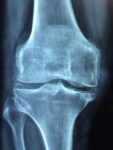
Knee pain? Ask for an X-ray to get to the bottom of it suggests new study
 X-rays remain the first – and best – screening tool for diagnosing knee pain in middle-aged people, suggests research published in the Journal of the American Academy of Orthopaedic Surgeons.
X-rays remain the first – and best – screening tool for diagnosing knee pain in middle-aged people, suggests research published in the Journal of the American Academy of Orthopaedic Surgeons.
Osteoarthritis is one of the most common reasons people experience knee pain. About 20% of people in the UK aged 45 years and older are thought to have knee osteoarthritis. This adds up to 4.11 million people in England.
Magnetic resonance imaging (MRI) can help doctors diagnose knee problems, but a simple X-ray is often the best diagnostic tool, reducing time and cost.
The study
Experts looked at 100 MRIs of knees from patients aged at least 40 years and found that:
- The most common reasons for knee pain are osteoarthritis (39%) and meniscal tears (29%);
- Nearly one-quarter of MRIs were taken before the patient had an X-ray;
- Only half of the MRIs obtained before meeting with an orthopaedic surgeon contributed to the diagnosis and treatment for osteoarthritis.
“Patients should always get weight-bearing X-rays before getting an MRI because MRIs are not always needed to diagnose knee problems,” says lead author, Dr Muyibat Adelani. “In cases where arthritis is suspected, weight-bearing X-rays often are more than enough for orthopaedists to complete the diagnosis and treatment plan. An appropriately timed consultation with an orthopaedic surgeon can be more cost effective than first obtaining MRI scans.”
For more in-depth features, interviews and information, subscribe to Arthritis Digest magazine, a popular title that’s published six times a year. Click here for the digital version or tel 0845 643 8470 to order your had copy. You’ll know what your doctor is talking about, what new drugs are in the pipeline and be up to date on helpful products.
